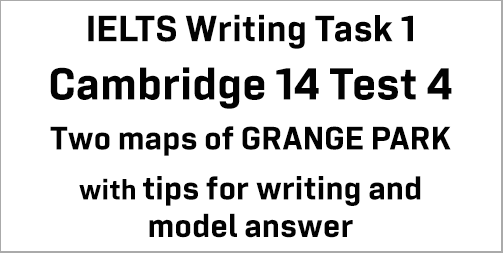IELTS Writing Task 1: Cambridge 14 Test 4; two maps of GRANGE PARK (1920 and present); with tips and model answer
This IELTS Writing Task 1 post focuses on Cambridge 14 Test 4 where two plans/maps are given of Grange Park depicting 1920 and present time. In this post, you’ll find a short discussion on the task with a model answer and some important tips that can help you write this type of diagrams easily.
Let’s take a look at the question first:
The plans below show a public park when it first opened in 1920 and the same park today.
Summarise the information by selecting and reporting the main features, and make comparisons where relevant.


Describing different locations /places in a map:
As an IELTS candidate, you are expected to describe different locations or places and the changes that take place in different maps. So, learning how to describe different places and the changes are essential.
When I was given two maps to describe some changes in my first IELTS exam, what I first did was marking the maps and highlighting the changes. I used some circles and different symbols to mark the changes. So, I advise you to mark the differences in different parts of the maps with a pencil and write any important word that hits your mind. This will help you write the answer in a more organised way.
Tips for writing answer for a map/maps:
- Scan the maps carefully.
- Mark the differences in the maps with a pencil.
- Write some unique vocabulary on the map.
- Follow a two/three-paragraph structure.
- Don’t write any conclusion; rather focus on writing an overall statement right after the introductory sentence.
- Use words such as ‘north’, ‘south’, ‘east’, ‘west’, ‘eastern’, ‘western’, ‘northern’, ‘southern’, etc. if you find a compass in the maps. However, if there’s no compass, use ‘right’, ‘left’, ‘top’, ‘bottom’ etc. to explain the maps.
- Be careful about using tenses.
Model answer for the question:
The displayed maps feature the changes in Grange Park (situated between Arnold Avenue and Eldon Street) from 1920 to date. On the whole, the park has witnessed massive changes in areas primarily related to amusement with significant rearrangement in terms of seating.
The most conspicuous change has been made in the middle by replacing the fountain with a rose garden with seating arrangements around it. Moreover, to the left of the new rose garden, the stage for musicians has also been substituted by an amphitheatre for concerts that looks quite humongous in size. The seating on the far left side, as well as the rose garden in the bottom left corner of the map, has been removed.
Furthermore, both the entrances at the top and bottom of the map have remained untouched. However, the rose garden on the right side has been replaced with a café while the Pond for water plants has been transformed into a children’s play area. The glasshouse with some seats has been knocked down and a beautiful water feature has been constructed. Besides, a completely new entrance has been built that leads to an underground car park.
(191 words)




One thought on “IELTS Writing Task 1: Cambridge 14 Test 4; two maps of GRANGE PARK (1920 and present); with tips and model answer”